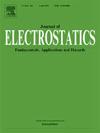不同浓度溴化阻燃剂对ABS和PS颗粒摩擦充电性能的影响
IF 2.1
4区 工程技术
Q3 ENGINEERING, ELECTRICAL & ELECTRONIC
引用次数: 0
摘要
-废塑料是一个重要的污染源,因为它们含有被认定为持久性有机污染物(POPs)的物质,例如溴化阻燃剂(bfr)。这些物质被添加到许多高分子材料中,以符合安全可燃性标准,增强其耐火性,延迟点火,减缓火势蔓延,或延迟闪络时间。在塑料材料的使用、处置和回收过程中,溴化阻燃剂会释放到环境中;它们需要仔细管理,以减少与它们对人类健康的危险性质有关的风险。在WEEE中发现的塑料中,丙烯腈-丁二烯-苯乙烯(ABS)和聚苯乙烯(PS)是最普遍的,因为它们具有优异的绝缘和机械性能,对电气和电子设备领域至关重要。然而,它们的高可燃性使它们成为添加高水平bfr的特别目标,以增强其耐火性并符合安全标准。此外,它们相似的表面性质和相近的质量密度值极大地限制了湿法分离方法,如密度法和浮选法。在这种情况下,摩擦静电分离可能是一种低成本、低污染的解决方案,可以保持塑料的原始特性。之所以选择摩擦静电分离而不是湿法,是因为它是一种干法,不需要化学预处理,不需要昂贵的润湿试剂,而且还消除了废水处理问题。这种方法利用了ABS和PS摩擦电性能的差异,使它们在不改变化学结构的情况下分离,这对保持可回收性至关重要。本文的目的是研究不同浓度的BFR在ABS和PS材料中的存在对溴化ABS和PS颗粒摩擦电荷特性和摩擦静电分离过程的影响。利用流化床摩擦增压器研究了溴化塑料颗粒的摩擦充电性能。摩擦充电实验中使用的溴化聚合物为无BFR ABS、0.23% BFR ABS、4.6% BFR ABS、无BFR PS、0.23% BFR PS和4.6% BFR PS,由法国crit公司生产,以六溴苯为BFR模型。在实验的第一部分,本工作研究了摩擦增充剂壁材的影响,BFR ABS和PS塑料的摩擦电行为,它们的电荷密度随时间的变化,最后是摩擦充电时间的影响。实验第二部分对不同混合物(无BFR ABS/无BFR PS、4.6% BFR ABS/ 4.6% BFR PS等)进行摩擦-静电分离试验。本文章由计算机程序翻译,如有差异,请以英文原文为准。
Triboelectric charging properties of ABS and PS granules with different concentration of Brominated flame retardants
— Waste plastics are a significant source of pollution as they contain substances identified as persistent organic pollutants (POPs), such as brominated flame retardants (BFRs). These substances are added to many polymer materials to comply with safety flammability standards, to enhance their fire resistance, delay ignition, slow the spread of fire, or delay the time of flashover. BFRs are released from plastic materials into the environment during use, disposal, and recycling; they require careful management to reduce the risks associated with their dangerous nature for human health. Among the plastics found in WEEE, Acrylonitrile Butadiene Styrene (ABS) and Polystyrene (PS) are the most prevalent, as their excellent insulating and mechanical properties render them essential for the electrical and electronic equipment sector. However, their high flammability makes them particularly targeted for the addition of high levels of BFRs to enhance their fire resistance and comply with safety standards. Moreover, their similar surface properties and close mass density values significantly limit wet separation methods, such as density and flotation methods. In this case, tribo-electrostatic separation might be a low-cost, low-polluting solution that can preserve the original properties of plastic. Tribo-electrostatic separation was chosen over wet methods because it is a dry process that requires no chemical pretreatment, no expensive wetting reagents, and also eliminates wastewater treatment issues. This method exploits the differences in triboelectric properties of ABS and PS, enabling their separation without altering their chemical structure, which is critical for preserving recyclability. The aim of this paper was to investigate the effect of the presence of BFR with different concentrations in ABS and PS materials on their triboelectric charging characteristic and tribo-electrostatic separation process of brominated ABS and PS particles. The tribocharging properties of brominated plastic particles were studied by a fluidized bed tribocharger. The brominated polymers used in the tribocharging experiments were BFR-free ABS, 0.23 % BFR ABS, 4.6 % BFR ABS, BFR-free PS, 0.23 % BFR PS, and 4.6 % BFR PS, produced by CRITT France, using hexabromobenzene as a model of BFR. In the first part of the experiments, this work investigated the influence of the tribocharger wall material, the triboelectric behavior of BFR ABS and PS plastics, their charge density evolution over time, and finally the effect of tribocharging duration. In the second part of the experiments, tribo-electrostatic separation tests were conducted on different mixtures (BFR-free ABS/BFR-free PS, 4.6 % BFR ABS/4.6 % BFR PS, etc.).
求助全文
通过发布文献求助,成功后即可免费获取论文全文。
去求助
来源期刊

Journal of Electrostatics
工程技术-工程:电子与电气
CiteScore
4.00
自引率
11.10%
发文量
81
审稿时长
49 days
期刊介绍:
The Journal of Electrostatics is the leading forum for publishing research findings that advance knowledge in the field of electrostatics. We invite submissions in the following areas:
Electrostatic charge separation processes.
Electrostatic manipulation of particles, droplets, and biological cells.
Electrostatically driven or controlled fluid flow.
Electrostatics in the gas phase.
 求助内容:
求助内容: 应助结果提醒方式:
应助结果提醒方式:


